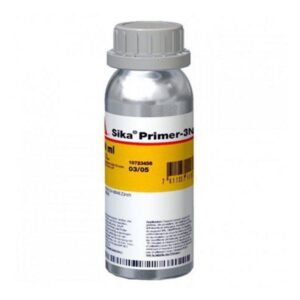What is the difference between primer and sealant?
When we talk about sealants in this context, we are referring to the liquid coats that are used to seal surfaces such as wood or plaster to prevent them from absorbing paint or vanish. Some sealants can be transparent, and double as a primer. Other may be formulated to remain uncoated.
The term primer (literally meaning ‘first’), on the other hand, is used to describe the first coat you apply when painting a surface such as timber, steel or any other material. As well as porous surface primers, there are products such as the Everbuild Sealant Primer NP2 formulated to work on most common non porous building materials (e.g. glass, uPVC, aluminium, and ceramics). The primer is commonly considered as the most important coat applied to a substrate, as the final finish depends on the priming process.
Often, primers are used as a method of adhering subsequent coats of paint to the surface. In addition to adding some pigment to the surface, some primers can act as corrosion inhibitors, prevent discolouration of the topcoat or make it more uniform.
Both primers and sealers are also used to keep any surface stains from bleeding through the paint. This quality is particularly useful when painting wooden surfaces such as mahogany, redwood or cedar. While sealants share many properties with primers, they are more commonly used on porous surfaces like masonry or new wood which are more likely to absorb coats of paint unevenly.
Many brands now offer products that can be used as both a sealer and a , so you can benefit from all the advantages of adhesion and sealing in a single package.
What is the purpose of a primer?
Surface preparation is one of the most overlooked steps in an installation process because of the extra time it involves. In fact, priming surfaces is often skipped altogether, despite primers’ ability to greatly improve the adhesion of overlaying compounds, making the whole installation more durable and secure and with a finish of greater quality.
As well as improving the adhesion of non-porous materials, primers are used as a preparatory coating which regulates the absorption rate of porous substrates. Overlooking the application of an appropriate primer might lead to poor bonding of substrates and, ultimately, to the de-bonding of coverings.
Skipping the primer and moving directly to the colour coats can often backfire, as the surface will likely require at least one extra coat of paint, which is a waste of both time and money, since paint is more expensive than primer.
By sealing porous surfaces such as drywall and raw wood, primers keep the surfaces from soaking up too much paint too quickly, making sure you get the most from your paint. In addition to saving on paint, you will also be saving time and effort if you opt for a primer, as it dries quickly and allows you to apply the topcoat sooner.
As well as new wood and other unpainted surfaces, we also advise using a primer (or sealant) if you’re repainting uneven or damaged surfaces. Make sure to thoroughly clean and sand the surface before applying the primer and repainting.
How do primers work?
Before you apply a primer, we recommend you make sure that you’ve undertaken thorough surface preparation – otherwise, all its properties will be wasted. Ensure that the surfaces you are painting have been meticulously cleaned from any contaminants and remove any sharp edges if you are working with materials such as timber or steel.
To create a uniform surface for the finish coat, primers adhere to the substrate, smoothing out the porosity of unpainted surfaces. The topcoat can then in turn stick to the primer. Depending on the surface they are designed for, primers also contain special ingredients which enrich the material and help target specific issues that might arise during application.
Both latex and oil-base wood primers contain specialised ingredients that can’t always be found in topcoats, or at least not in such amounts. Such ingredients include wood preservatives and stain-inhibiting tannin blockers, which prevent tannins from staining the topcoat by seeping into the raw wood and sealing it.
What primer you use also depends on whether the surface is outdoor or indoor. Oil-based wood primers, for example, offer better surface penetration, which makes them great for raw interior wood. Latex primers, meanwhile, are more suitable for exterior applications since they are more flexible and are therefore able to expand or contract to accommodate temperature changes.
Of course, you are not solely limited to those two types either – water-based, shellac-based and solvent based primers (such as the Sika Primer 3N) are just a few more of the options available on the market. Contact our team and we can help you choose the primer best suited for the surface you’re painting.
The main function of primers
Primers also serve a range of other functions. They protect subcases from the elements until a top coat is applied, e.g. blocking UV light from damaging exterior substrates or preventing moisture from getting into the material.
Primers also have material-specific functions. Wood primers, for instance, often contain fungicides which prevent the growth of mould. Anti-corrosive pigments are also often used in non-ferrous metal primers to keep the surface from corroding and in wood primers to keep nail heads from corroding.
Primer for joint sealant
Primers are also used in concrete joints before applying joint sealant on top of a filler to waterproof the surface and prepare it for joint sealant adhesion.
How long should primer dry before painting?
It usually takes latex primers between half an hour and an hour to dry, but we don’t recommend applying paint coats until the surface has dried thoroughly. This usually takes around three hours, but cool temperatures and high humidity can prolong the process. The ideal drying temperature for primers will vary depending on the brand, but most of the time it will be approximately 25 degrees Celsius at 50 percent relative humidity.
Where to buy primers for porous and non-porous surfaces?
We supply a range of primers all common types of silicone, polyurethane and hybrid sealants from a number of industry-leading brands, including Everbuild Sealant Primer P1.

